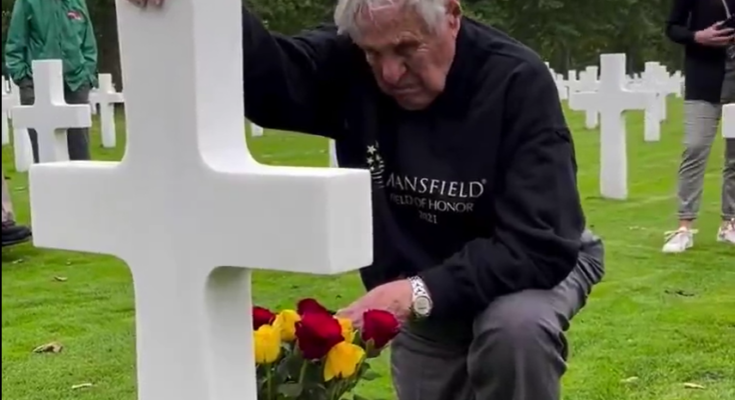The morning sun cast long, gentle rays across the quiet cemetery, illuminating the rows of white headstones that stretched into the horizon. It was a place of solemn reflection, a landscape of memory where the sacrifices of a generation were etched in stone and whispered in the winds of time. Among these silent sentinels of history, one figure moved with a mixture of reverence and quiet anticipation—a man whose life had been shaped by the turbulence of war, whose heart had carried the weight of loss for nearly eight decades. William “Bill” Hargrove, now a nonagenarian, had survived countless missions, faced enemy fire, and witnessed the fragility of life in the skies above Europe during World War II. Today, he was on a deeply personal mission: to find the final resting place of his fallen wingman, James “Jimmy” Callahan, whose life had been tragically cut short in the midst of battle nearly eighty years ago.

Bill’s journey had begun many years earlier, in the blistering skies over occupied France. As a young fighter pilot, he and Jimmy had formed a bond forged in the crucible of combat—a partnership built on trust, camaraderie, and an unspoken understanding that each would watch over the other, no matter the cost. Flying formations, dodging anti-aircraft fire, and engaging enemy fighters demanded split-second decisions and absolute reliance on one another. In those moments, the bond between pilots transcended words. Jimmy was more than a colleague; he was a brother-in-arms, a confidant, and a friend whose laughter had cut through the tension of war, whose courage had inspired those around him. The memory of that laughter, now faint and distant, had lingered in Bill’s heart all these years, alongside the haunting recollection of the fateful day when Jimmy did not return.
The mission that changed everything had been one of the many that defined Bill’s wartime experience. Their squadron had been tasked with escorting bombers deep into enemy territory—a mission fraught with danger and uncertainty. Flying in tight formation, they navigated the clouds and the chaotic maelstrom of anti-aircraft fire below. Suddenly, amidst the roar of engines and the whistling of shells, Jimmy’s aircraft had been struck. Bill had witnessed the plane spiral, helplessly, into the earth below. The sensation of loss had been immediate and overwhelming, an anchor of sorrow that would follow him for decades. Despite countless letters home, military records, and official reports, Jimmy’s final resting place remained unknown, a mystery that lingered like a shadow over Bill’s long life.

The decades that followed saw Bill navigating a world that had moved on while he carried the past within him. He had married, raised a family, and settled into civilian life, but the memory of Jimmy’s sacrifice remained a constant presence. Every Veterans Day, every remembrance ceremony, every mention of the fallen stirred the familiar ache of loss. In quiet moments, Bill would pore over archives, maps, and military records, piecing together fragments of information in the hope of finding closure. Advances in technology, digitization of military records, and the tireless work of historians and genealogists eventually provided him with a glimmer of hope—a trail that suggested the possible location of his friend’s grave in a small cemetery in northern France.
Arriving in France, Bill was struck by the serene beauty of the countryside, so different from the chaos of war he had once known. Rolling fields, quaint villages, and the gentle hum of life provided a stark contrast to the memories that had haunted him for nearly eighty years. Guided by historical records, local authorities, and the assistance of military historians, he made his way to the cemetery. Every step was imbued with anticipation and the gravity of history. The rows of graves seemed endless, each stone a testament to sacrifice, each name a story of courage, loss, and endurance. Bill’s heart raced as he approached the section where the records indicated Jimmy might be buried.
Finally, after meticulous searching and confirmation with cemetery records, Bill stopped before a modest headstone bearing the name James Callahan. The inscription was simple yet profound: a testament to a life given in service of freedom. Time seemed to slow as Bill knelt before the grave, feeling the weight of decades collapse into this single, poignant moment. Tears welled in his eyes, unashamedly, as he traced the carved letters with trembling fingers. Memories of Jimmy’s laughter, bravery, and the bond they had shared flooded back, vivid and alive. Here, at last, was the closure he had sought for nearly eighty years—a chance to honor his friend, to speak words that had remained unspoken, and to pay tribute to the sacrifices that define true camaraderie.
The visit was not just a private act of remembrance; it resonated with a broader significance. Bill’s story captured the attention of local communities, historians, and journalists, eager to share this remarkable reunion with the world. Social media platforms buzzed with stories of the elderly pilot finally finding his wingman’s resting place, inspiring readers with a narrative of loyalty, friendship, and the enduring human spirit. Interviews and documentaries highlighted not only the personal journey of Bill and Jimmy’s enduring bond but also the historical context of their service, the challenges faced by WWII pilots, and the countless untold stories of bravery that remain hidden in the annals of history.
Bill spent hours at the grave, recounting stories aloud, imagining conversations that could never be held in life. He spoke of shared missions, near-misses, victories, and moments of levity that punctuated the otherwise grim reality of war. The simple act of speaking to the gravestone became a form of healing, a bridge between the past and present. Visitors to the cemetery, moved by the sight of the elderly pilot honoring his friend, offered quiet companionship and shared their own reflections on sacrifice, loyalty, and the passage of time. The experience underscored the timeless truth that while war may claim lives, the bonds forged in its crucible endure, transcending generations and geography.
In reflecting on the decades that separated the moment of loss from the moment of reunion, Bill expressed a profound sense of gratitude. Gratitude for the technology and historical research that enabled him to locate Jimmy’s grave, gratitude for the support of historians and community members, and most importantly, gratitude for the enduring friendship that had defined so much of his life. The reunion was not merely about finding a grave; it was about honoring a shared history, acknowledging the sacrifices made, and celebrating the strength of human connection. In many ways, it was a testament to the enduring power of memory, a reminder that even after nearly a lifetime, it is never too late to pay homage to those who shaped our lives.
The story also highlights the broader legacy of WWII veterans and the importance of remembering their service. As the last remaining members of that generation age, stories like Bill’s serve as vital links to a history that must not be forgotten. Each gravestone, each photograph, each recorded memory is a repository of lessons, courage, and the resilience of the human spirit. By finding Jimmy’s grave, Bill not only honored his personal bond but also contributed to the collective memory of a generation, ensuring that the sacrifices of those who fought for freedom continue to inspire and educate future generations.
The emotional resonance of Bill’s journey extends beyond personal closure. It serves as a reminder of the fragility and preciousness of life, the importance of friendship, and the enduring impact of acts of courage. In a world often preoccupied with the immediacy of daily concerns, such stories provide a lens through which to appreciate the depth of human experience, the sacrifices made for others, and the ways in which history continues to shape contemporary life. Bill’s pilgrimage to Jimmy’s grave underscores the timeless truth that bonds forged in adversity are never truly broken, and that acts of remembrance carry profound significance, not just for those directly involved, but for all who bear witness.
The reunion also prompted reflection on the broader human capacity for resilience and forgiveness. War leaves scars that are both visible and invisible, and the act of honoring those lost allows for healing and reconciliation. Bill’s visit to the cemetery exemplified the courage required to confront the past, to face loss, and to seek closure in a manner that respects both memory and history. It also offered a profound lesson in humility, reminding all who heard his story that life is fleeting, that relationships matter, and that the passage of time cannot diminish the importance of honoring those who came before us.
In sharing his story, Bill became a symbol of dedication, loyalty, and the enduring bonds of friendship. His experience resonates with anyone who has lost a friend, faced adversity, or carried the weight of unresolved grief. By finding Jimmy’s grave, he transformed decades of longing into a moment of connection, a tangible affirmation of the ties that bind us across time and space. The narrative invites reflection on the nature of memory, the power of human connection, and the ways in which acts of remembrance shape our understanding of life, loss, and legacy.
The discovery of the grave also reinvigorated discussions about preserving history and honoring veterans. Communities and organizations dedicated to remembering the contributions of WWII veterans were inspired by Bill’s story, recognizing the importance of documenting personal narratives, maintaining cemeteries, and ensuring that future generations understand the sacrifices made in the pursuit of freedom. Educational initiatives, exhibitions, and commemorative events drew upon the story to illustrate broader historical themes, enriching public understanding and appreciation of a pivotal era in human history.
In the end, the journey of William Hargrove to find James Callahan’s grave after nearly eighty years stands as a testament to the enduring nature of friendship, the importance of remembrance, and the resilience of the human spirit. It reminds us that history is not merely a series of dates and events, but a tapestry woven from the experiences, sacrifices, and connections of real people. Bill’s story exemplifies the profound impact that one individual’s dedication can have, not only on personal closure but also on the collective memory of society. It is a story of courage, loyalty, and the timeless power of human connection—a story that will inspire and resonate for generations to come.
As Bill left the cemetery, he carried with him a sense of peace that had eluded him for decades. The sun dipped low on the horizon, casting a warm glow over the headstones, and a gentle breeze seemed to whisper through the trees, carrying with it the echoes of the past. In that moment, Bill felt a profound sense of completion—a bridge between the days of youthful flight and the quiet reflection of age. He had fulfilled a promise, honored a friendship, and witnessed the enduring truth that while time may pass, the bonds forged in adversity remain eternal. His journey serves as a powerful reminder of the significance of memory, the courage to confront the past, and the enduring legacy of those who have given everything in the name of duty, honor, and friendship.



